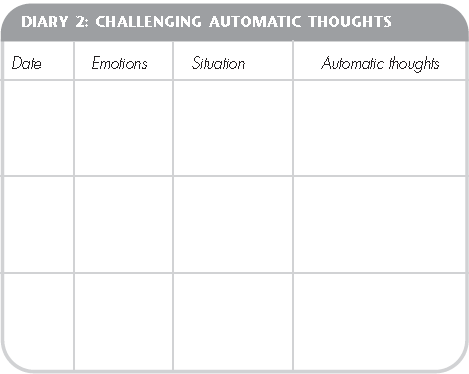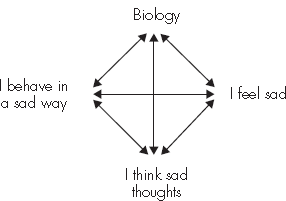
The diagram below shows how thoughts, behavior and mood are inter-related, and how a vicious circle can arise as a result.
Figure S3.1 The inter-relation of thoughts, behavior and mood

For instance, imagine for example you caught a cold. The physical effects that this has on you (biology) make you feel weak and apathetic. This in turn may make you think more negatively, e.g. ‘I look so awful today – all pale and puffy faced. I’d better stay in.’ The result of thinking this in turn affects your behavior in that you stay inside longer. By staying in, you may get bored and start to feel more negative about yourself – and thus the cycle is perpetuated.
In the same way, a vicious circle is set up in AN. The effect of thinking about fat and how you ought to be thinner has a direct effect on your behavior, prompting you to diet, starve, exercise, vomit, etc. These behaviors lead to restricting food intake and therefore trigger more thoughts about food and eating. This restrictive eating pattern also has a direct effect on your biology – it causes lack of concentration, sleep disturbance, irregular periods and so on – and often results in you feeling low in mood.
Figure S3.2 Effects of starvation on biology
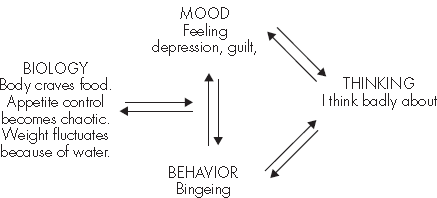
Can you think of any examples of vicious cycles like this affecting you? Write down some examples using the model contained in the diagram to make links between biology, behavior, thinking and mood.
There is little you can do directly to change your mood, although some medications may help by working on the biological symptoms of depression. What you can do is learn to think less negatively about yourself, about food and about your weight. This will enable you to change your behavior, introducing the principles of normal eating, and thus to break out of the cycle. Cognitive behavioral therapy provides a way of doing this.
AN is an eating disorder which affects your mood and the way you think, feel, behave and interact in relationships. Even when the behavioral symptoms of AN have disappeared and you are eating normally, the anorexic thoughts or preoccupations with food, weight and eating often remain.
Figure S3.3 AN affects your behavior, thoughts, mood and relationships
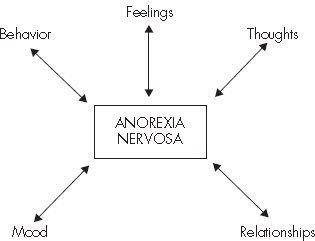
Typical anorexic thoughts include:
These thoughts, while they seem to make sense on the surface, are distorted and are not helpful to you, because the issues around which they revolve may have come to preoccupy most if not all your thoughts, so that you are unable to apply yourself properly to anything else; in other words, they have come to dictate how you lead your life. These thoughts also impede progress because they represent arguments that encourage you to maintain your faulty eating pattern.
Typically, someone with AN believes that she is the only person in the world who thinks and behaves as she does, but when she talks to others with AN is amazed to find that there are many in exactly the same position as herself.
Cognitive distortions – distortions in the way you think – don’t just affect you. If you think in this way, you will have a negative view not only of yourself, but of the future and of the world around you. (This triad can also occur in depression, BN and severe anxiety.)
Cognitive behavioral therapy is aimed at helping you learn to recognize errors in your thinking which prevent you from changing your behavior. By using this manual, which is based on a cognitive behavioral approach, you will:
Having automatic thoughts is normal. Everyone has them, and they can be ‘good’, ‘bad’ or ‘indifferent’. We will all have thoughts running through our minds the whole time, although we are not always conscious of what we are actually thinking. Nor do we normally question our own thinking; therefore, even if it becomes excessively negative or self-critical, we tend just to believe that the thoughts are factual. However, how one thinks about oneself can be very strongly affected by all sorts of factors such as life circumstances, self-confidence, body image, etc.
If you have AN, you probably have powerful automatic thoughts that come into play to prompt you to starve or exercise excessively. In this step you will learn to recognize and counter your own ‘automatic thoughts’; but first you must be quite sure of what an automatic thought is.
The next step is to record your negative thoughts in your diary. If you start to feel bad for any reason, review your thoughts. Try to catch exactly what has just passed through your mind. These are the thoughts to write down; they can be seen as your automatic reactions, either to something that has just happened or to an issue which you have been thinking about, such as your AN. You will probably find that these thoughts are very negative and that you believe them.
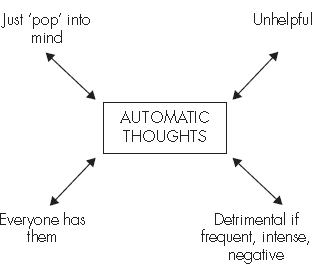
It is important to try to recognize some negative thoughts of your own. Below is an excerpt from the cognitive therapy diary of a 21-year-old student who had suffered from AN for four years. This may help you to identify some of your own negative automatic thoughts. If so, jot some of them down in the blank diary page provided (or on the larger, blank versions provided at the back of the book). Don’t worry if none comes to mind immediately. You will have a chance over the next week to add some to your food diary.
The typical automatic thoughts of a person suffering from an eating disorder tend to be preoccupied with food, weight and shape. Some further examples are:
